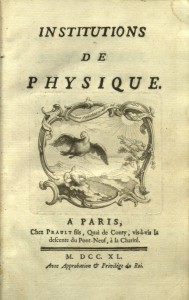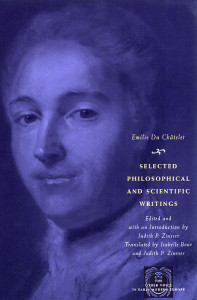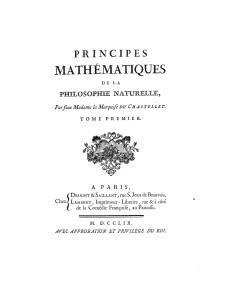
Commentary on Newton’s Principia / Principes Mathematiques de le Philosophie Naturelle by Emilie du Châtelet
In her scientific works, Emilie du Châtelet’s crowning achievement is considered to be her translation and commentary on Isaac Newton‘s work Principia Mathematica. The translation, published posthumously in 1759, is still considered the standard French translation.
While Du Châtelet’s primary interest was in natural philosophy or the philosophy of nature (from Latin philosophia naturalis), the philosophical study of nature and the physical universe that was dominant before the development of modern science. She also had interests in ethics (translating of portions of Mandeville’s Fable of the Bees), theology and the Bible (writing a book titled Examens de la Bible), and the source of human happiness (writing a semi-autobiographical book, Discours sur le bonheur). Her non-scientific work also commented on the subject of women’s social roles and their education.
The Education of 18th Century Women
“I feel the full weight of the prejudice which so universally excludes us from the sciences; it is one of the contradictions in life that has always amazed me, seeing that the law allows us to determine the fate of great nations, but that there is no p lace where we are trained to think…Let the reader ponder why, at no time in the course of so many centuries, a good tragedy, a good poem, a respected tale, a fine painting, a good book on physics has ever been produced by women. Why these creatures who se understanding appears in every way similar to that of men, seem to be stopped by some irresistible force, this side of a barrier. Let the people give a reason, but until they do, women will have reason to protest against their education…If I were king…I would redress an abuse which cuts back, as it were, one half of human kind. I would have women participate in all human rights, especially those of the mind. It would seem as if they were born only to deceive — this being the only intellectual exercise allowed them. The new education would greatly benefit the human race. Women would be worth more and men would gain something new to emulate…I am convinced that either many women are unaware of their talents by reason of the fault in their edu cation or that bury them on account of prejudice for want of intellectual courage. My own experience confirms this. Chance made me aquatinted with men of letters who extended the hand of friendship to me…I then began to believe that I was a being with a mind…” ~ Emilie du Châtelet – Introduction to her Translation of I Bernard Mandeville’s The Fable of the Bees (1735)
Scientific Works
Dissertation sur la nature et la propagation du feu / Dissertation on the Nature and Propagation of Fire (1st edition, 1739; 2nd edition, 1744)
Institutions de physique / Foundations of Physics (1st edition, 1740; 2nd edition, 1742)
Réponse de Madame la Marquise du Chastelet, a la lettre que M. de Mairan / Response of Emilie Du Chatelet to a letter of Monsieur Mairan (1741)
Principes mathématiques de la philosophie naturelle par feue Madame la Marquise du Châtelet / Commentary on Newton’s Principia (1st edition, 1756; 2nd edition, 1759)
Other Works
Translation of I Bernard Mandeville’s The Fable of the Bees (1735)
Grammaire Raisonée / Reasons for Grammar (1736)
Examen de la Genèse / Examinations of the Genesis
Examen des Livres du Nouveau Testament / Examinations of the books of the New Testament
Discours sur le bonheur / Discourse on Happiness
Translation of Selected Philosophical and Scientific Writings of Emilie du Châtelet by Judith Zinsser available on Amazon
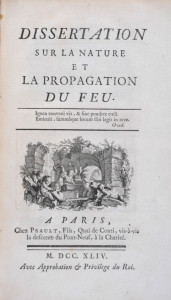
Dissertation sur la nature et la propagation du feu / Dissertation on the Nature and Propagation of Fire ~ 1st edition, 1739 by Emilie du Châtelet
Infrared Radiation
In 1737, Châtelet published a paper entitled Dissertation sur la nature et la propagation du feu, based upon her research into the science of fire, that predicted what is today known as infrared radiation and the nature of light.
Foundations of Physics
Her book Institutions de Physique (“Lessons in Physics”) appeared in 1740; it was presented as a review of new ideas in science and philosophy to be studied by her thirteen-year-old son, but it incorporated and sought to reconcile complex ideas from the leading thinkers of the time.
Advocacy of kinetic energy
Du Chatelet combined the theories of Gottfried Leibniz and the practical observations of Willem’s Gravesande to show that the energy of a moving object is proportional not to its velocity, as had previously been believed by Newton, Voltaire and others, but to the square of its velocity or F=mv² (In classical physics, the correct formula is Ek = 1⁄2mv² where Ek is the kinetic energy of an object, m = mass and v = velocity.)
To explain further, “in the history of science, vis viva (from the Latin for living force) is an obsolete scientific theory that served as an elementary and limited early formulation of the principle of conservation of energy. It was the first known description of what we now call kinetic energy or of energy related to sensible motions.
Although ancient philosophers as far back as Thales of Miletus had inklings of the law of conservation of energy, it was the German Gottfried Wilhelm Leibniz during 1676–1689 who first attempted a mathematical formulation. Leibniz noticed that in many mechanical systems (of several masses, mi each with velocity vi) the quantity: was conserved. He called this quantity the vis viva or living force of the system. The principle, it is now realized, represents an accurate statement of the conservation of kinetic energy in elastic collisions, and is independent of the conservation of momentum. However, many physicists at the time were unaware of this fact and, instead, were influenced by the prestige of Sir Isaac Newton in England and of René Descartes in France, both of whom had set great store by the conservation of momentum as a guiding principle. Thus the momentum was held by the rival camp to be the conserved vis viva. It was largely engineers such as John Smeaton, Peter Ewart, Karl Holtzmann, Gustave-Adolphe Hirn and Marc Seguin who objected that conservation of momentum alone was not adequate for practical calculation and who made use of Leibniz’s principle. The principle was also championed by some chemists such as William Hyde Wollaston.
The French mathematician Émilie du Châtelet, who had a sound grasp of Newtonian mechanics, developed Leibniz’s concept and, combining it with the observations of Willem’s Gravesande, showed that vis viva was dependent on the square of the velocities. In 1722 Gravesande published the results of a series of experiments in which brass balls were dropped from varying heights onto a soft clay surface. He found that a ball with twice the speed of another would leave an indentation four times as deep, from which he concluded that the correct expression for the “live force” of a body in motion (what is modernly called its “kinetic energy”) is proportional to mv2.” ~ Wikipedia Commons Vis Viva Explanations
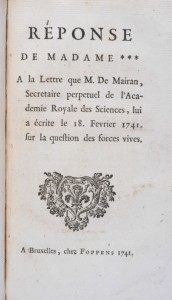
Réponse de Madame la Marquise du Chastelet, a la lettre que M. de Mairan / Response (1741) by Emilie du Châtelet
A Woman of Scientific Democracy
In 1741, Emilie became embroiled in a debate in which her defense of Leibniz’s formula resulted in public ridicule and a response from Jean-Jacques d’Ortous de Mairan, head of the French Academy of Sciences. Mairan sought to put her in her place by advocating mv as the proper interpretation. Emilie’s spirited public response advocating an Englishman’s formula (Newton) defended by a German’s (Leibniz) equation resulted in his withdrawing from the controversy. She had over 500 copies of her letter (Réponse de Madame la Marquise du Chastelet, a la lettre que M. de Mairan / Response of Emilie Du Chatelet to a letter of Monsieur Mairan) printed and distributed throughout Paris with the scathing conclusion, “A more ample refutation would have been possible, if I had wanted to bore my readers.” Monsieur Mairan withdrew from the argument without a word of defense for himself and France.
Einstein’s take on an Old Formula
“Over time, physicists became used to multiplying an object’s mass by the square of its velocity (mv2) to come up with a useful indicator of its energy. If the velocity of a ball or rock was 100 mph, then they knew that the energy it carried would be proportional to its mass times 100 squared. If the velocity is raised as high as it could go, to 670 million mph, it’s almost as if the ultimate energy an object will contain should be revealed when you look at its mass times c squared, or its mc2.
This isn’t a proof, of course, but it seemed so natural, so “fitting,” that when the expression mc2 did suddenly appear within Einstein’s more detailed calculations, it helped make more plausible his startling conclusion that the seemingly separate domains of energy and mass could be connected, and that the symbol c—the speed of light—was the bridge.” ~ David Bodanis Read More
Translation and commentary on Newton’s Principia
In 1749, the year of her death, she completed the work regarded as her outstanding achievement: her translation into French, with her commentary, of Newton’s Principia Mathematica, including her derivation of the notion of conservation of energy from its principles of mechanics. Published ten years after her death, today du Châtelet’s translation of Principia Mathematica is still the standard translation of the work into French.
As Emilie du Châtelet translated Newton’s Principia Mathematica, from Latin into French and she added a commentary. The commentary incorporated her work with Alexis de Clairaut with a section on tides which she summarized from a prize essay by Daniel Bernoulli, while the rest remains her original commentary.
Development of financial derivatives – High Stakes Gambling
Emilie loved to gamble. Voltaire would often observe her at play and once at Versaille’s she found herself to be losing a great deal of money. Voltaire whispered loudly in her ear, “You are losing because you are playing with cheats.” Such an indiscretion to declare the queen and her circles cheats, prompted a swift departure from Versailles, but the debt remained a enormous loss at a sum of 84,000 francs / 92,000 dollars. To quickly raise the money to pay back her debts, she devised an ingenious financing arrangement similar to modern derivatives, whereby she paid tax collectors a fairly low sum for the right to their future earnings (they were allowed to keep a portion of the taxes they collected for the King), and promised to pay the court gamblers part of these future earnings. Read original works and notes by Emilie – English Intro & French Text
SUGGESTED READING
Judith P. Zinsser. Emilie Du Châtelet: Daring Genius of the Enlightenment. New York: Viking, 2006.
2006 catalog from the French National Library Exhibition – Text in French
Judith P. Zinsser and Julie Candler Hayes, eds. Emile Du Châtelet: Rewriting Enlightenment
Philosophy and Science. SVEC [Studies on Voltaire and the Eighteenth Century] (2006:1)
Elisabeth Badinter. Les Passions intellectuelles. Paris: Fayard, 1999.
Mary Terrall.”Vis Viva.” History of Science 42 (2004): 189-209.
René Vaillot. Avec Mme Du Châtelet. 1734-1749. Edited by René Pomeau. Vol. I, Voltaire en son temps. Oxford: Voltaire Foundation, 1985-95.
Project Vox – An online source dedicated to including women in the canon of Modern Philosophy
View selected original works of Emilie du Châtelet – English Intro & French Text
Read about Emilie in Stanford’s Encyclopedia of Philosophy
Learn More About Emilie on Wikipedia

